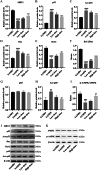Integrating network pharmacology and experimental validation to investigate the effects and mechanism of Renshen Shouwu decoction for ameliorating Alzheimer's disease
- PMID: 39417324
- PMCID: PMC11488172
- DOI: 10.1080/13880209.2024.2415660
Integrating network pharmacology and experimental validation to investigate the effects and mechanism of Renshen Shouwu decoction for ameliorating Alzheimer's disease
Abstract
Context: The mechanism of Renshen Shouwu Decoction (RSSW) in treating Alzheimer's disease (AD) remains unknown.
Objective: This study investigates the effects and mechanism of RSSW for ameliorating AD.
Materials and methods: Ten SAMR1 mice and 40 SAMP8 mice were divided into five groups: control (SAMR1), model (SAMP8), positive drug (Donepezil, 1.3 mg/kg/d), and RSSW (Low-dose, 117 mg/kg/d; High-dose, 234 mg/kg/d). Starting from 6 months of age, the medications were administered intragastrically for a total of 60 days. Subsequently, memory improvement in rapidly aging mice was assessed using the novel object recognition test and Morris water maze test. Through the identification of absorbed blood components and analysis of network pharmacology, active ingredients and potential targets involved in the treatment of AD were identified. Finally, AD-related biological indicators were detected using western blotting and ELISA.
Result: Our results demonstrated that RSSW effectively ameliorated memory impairments, inhibited tau hyperphosphorylation, and reduced β-amyloid plaque deposition in SAMP8 mice. Thirty absorbed blood components in RSSW were identified, revealing identified 96 major targets that play a key role in alleviating AD. Notably, the obtained main targets were highly enriched in SIRT1-mediated signaling pathways. Subsequent experimental validation confirmed that RSSW activated the SIRT1/NF-κB, SIRT1/AMPK, and SIRT1/p53 signaling cascades. Nine potential active ingredients were predicted through molecular docking.
Discussion and conclusions: Our research findings suggest the mechanism of RSSW treatment for AD, which ameliorates memory impairments by reducing cortical tissue inflammation and apoptosis.
Keywords: Polygoni multiflori; Radix Praeparata; Red ginseng; SIRT1; aging; apoptosis; inflammation.
Conflict of interest statement
No potential conflict of interest was reported by the author(s).
Figures





References
-
- Basheer N, Smolek T, Hassan I, Liu F, Iqbal K, Zilka N, Novak P.. 2023. Does modulation of tau hyperphosphorylation represent a reasonable therapeutic strategy for Alzheimer’s disease? From preclinical studies to the clinical trials. Mol Psychiatry. 28(6):2197–2214. doi: 10.1038/s41380-023-02113-z. - DOI - PMC - PubMed
-
- Bell L, Whyte A, Duysburgh C, Marzorati M, Van den Abbeele P, Le Cozannet R, Fança-Berthon P, Fromentin E, Williams C.. 2022. A randomized, placebo-controlled trial investigating the acute and chronic benefits of American Ginseng (Cereboost®) on mood and cognition in healthy young adults, including in vitro investigation of gut microbiota changes as a possible mechanism of action. Eur J Nutr. 61(1):413–428. doi: 10.1007/s00394-021-02654-5. - DOI - PMC - PubMed
MeSH terms
Substances
LinkOut - more resources
Full Text Sources
Other Literature Sources
Medical
Research Materials
Miscellaneous
